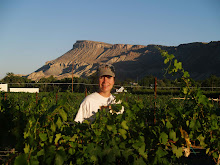
The grape growing has sadly ended. The harvest is off to the wineries to become those beautiful wines we love to taste. Thus, ends this season of Life in the Vines. It was fun. I appreciate all the support and I look forward to sharing the trials and tribulations of a harvest season next year. Yeah!
An appropriate ending to this Life in the Vines season, I've taken some information from WineBusiness.com that sums up what's going on with Malbec. It is exciting. It's exciting to grow the grape, make the wine, and wine drinkers everywhere are excited to drink it.
The reporters went to Mendoza, visited several wineries and talked with winemakers. They found people who were excited as well as dedicated. With the snow-capped Andes Mountains as a backdrop, the vineyards were stunning. There was a good mix of old-time, rustic wineries and gleaming, new, modern facilities. Clearly, Argentine winemaking was reinventing itself, and Malbec was the variety leading the charge.
There is no doubt that Malbec is succeeding. Sales in the United States are soaring. Exports of Malbec to the United States in 2005 saw 631,800 cases, an increase of 32.3 percent over 2004. Exports of Malbec in 2006 saw 903,800 cases, an even bigger increase of 44 percent over 2005. This upswing in Malbec sales has spurred more plantings of Malbec here in California and has caused the varietal prices to increase dramatically. And in Colorado. I believe we are the biggest growers of Malbec in the state of Colorado.
'Malbec is the primary variety associated with Argentina for a good reason. They work with Malbec that is pre-phylloxera genetic material planted to its own rootstock. The quality of this material is unique. It no longer exists, even in France. Malbec is a genetic treasure that Argentines happened to plant in the perfect place. Malbec is delicate at bloom time. It hates dry heat or wind during set. It doesn't like cold weather or a lot of rain. But grown in the well-drained soils of the Andes, Malbec has done very well, and at the higher elevation sites, it consistently gets ripe and seems to maintain acidity.
Argentina has a long, proud history of winemaking, but current, modern winemaking techniques have only been practiced for 20 years. In many ways, winemaking there is in its infancy. Winemakers are working hard to learn the modern ins and outs of their craft. They will soon have a better handle on how to grow perfectly ripened grapes and how best to use oak, micro-ox and other winemaking techniques. It is reasonable to assume that Malbec from Argentina is going to improve as time goes on.
Talking about his experiences working with Malbec in Argentina, Paul Hobbs once commented that he had learned "that culture is part of terroir." With that in mind, I set up this roundtable luncheon/interview at one of my favorite restaurants in Buenos Aires: Parrilla Don Julio. We sat at the table and ate our way through lush salads, spicy chorizos and enormous steaks. We had impassioned discussions and finished off most of 11 bottles of wine before the afternoon ended.
This passionate attitude about dining, discussion and camaraderie is an Argentine thing. It permeates every aspect of their daily lives. Along with their strong sense of family and country, it helps define who they are. Who is to say? I like to think that this attitude and way of life contribute a lot to the success of Argentine Malbec. wbm'
11 bottles in an afternoon? Now that's why I like growing grapes!
Remember imbibe and enjoy!

No comments:
Post a Comment